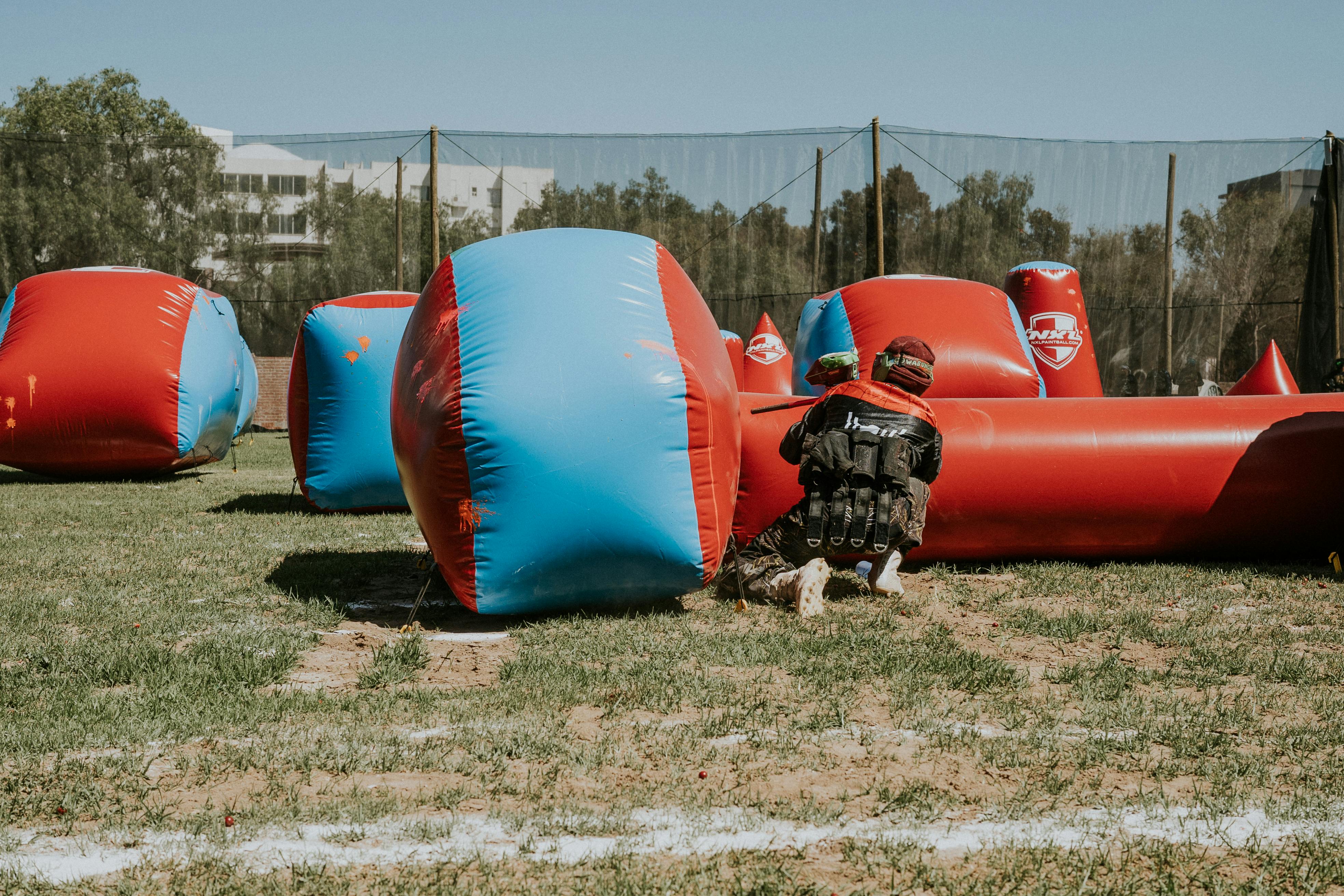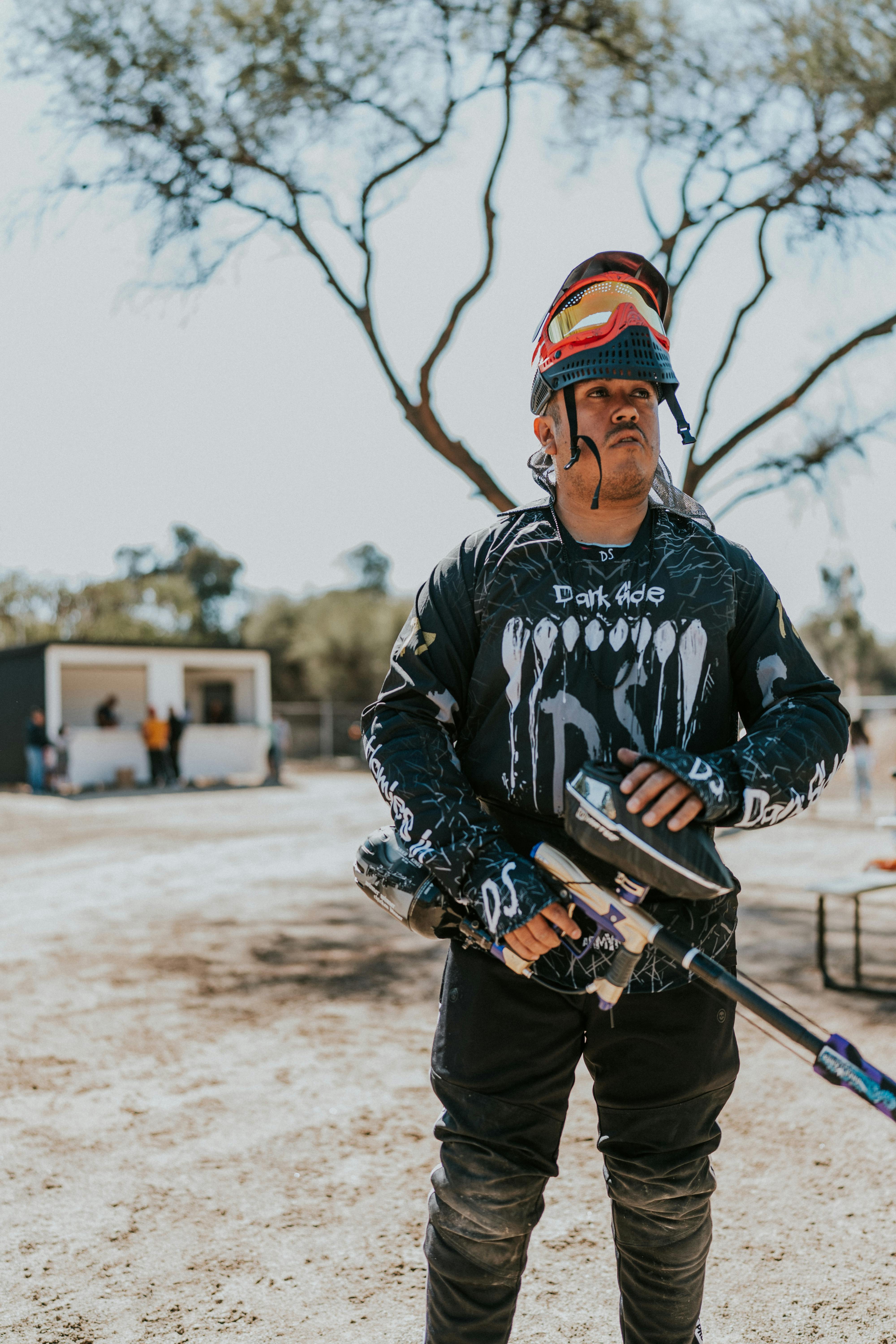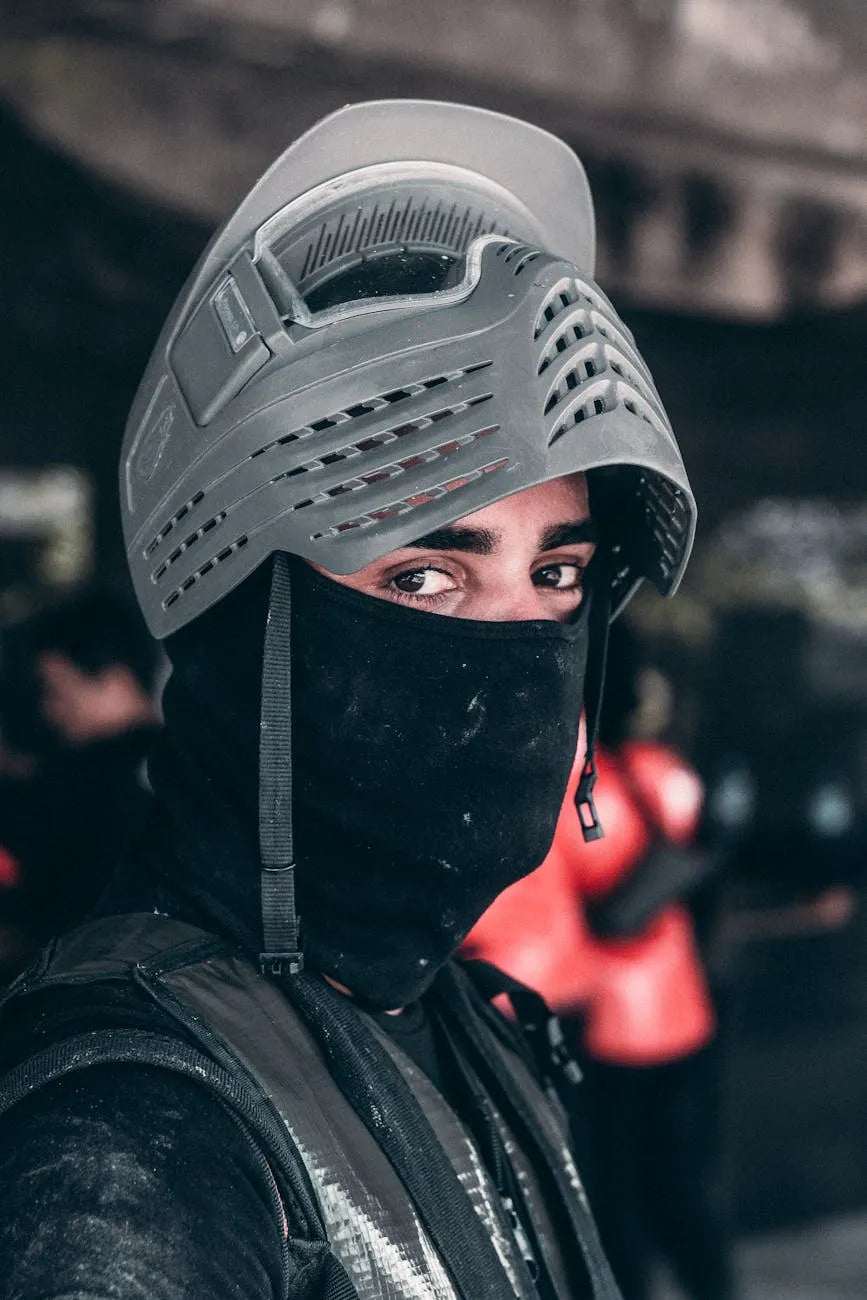What is Paintball 7 Essential Facts for 2025
Hello, I'm Elena Vasquez. You might know me on the field as "Strike." My journey into paintball wasn't typical. A chaotic birthday party years ago left me thinking it was just messy and uncontrolled. Fast forward through years as an ER nurse, a cycling accident forced me onto medical leave. That's when I rediscovered paintball in 2019. It wasn't chaos; it was strategy, a dynamic puzzle. My ER skills translated surprisingly well. Now, let's dive into what paintball truly is.
Paintball is a competitive team sport. Players eliminate opponents using paintball markers. These markers shoot spherical gelatin capsules filled with paint.
- Teams compete on designated fields.
- Objectives vary from elimination to capturing flags.
- Safety gear, especially masks, is mandatory.
Understanding the Basics of Paintball
The Core Concept: More Than Just Tag
Paintball combines elements of tag and hide-and-seek. Strategy and teamwork are crucial for success. It demands quick thinking and communication.
- Players use air-powered markers.
- Markers propel paintballs at controlled speeds.
- The goal is to mark opponents out of the game.
My first real taste of strategic paintball was eye-opening. Stuck observing due to my recovering shoulder, I saw the patterns. I realized how my ability to assess situations quickly in the ER applied here. Predicting movements became a fascinating challenge.
- Paintballs are typically .68 caliber (about 17.3mm).
- Some fields use smaller .50 caliber paintballs for lower impact.
- Paint is non-toxic and water-soluble.
The standard paintball weight influences its trajectory. Understanding this helps predict shots over distance. It's a game of physics as much as speed.
- Average .68 caliber weight: 3.0 - 3.2 grams.
- Average .50 caliber weight: ~1.25 grams.
- Shells are thin gelatin, designed to break on impact.
Safety First: Does Paintball Hurt?
This is often the first question I hear. Does getting hit by a paintball hurt? Honestly, yes, it can sting. The sensation is often compared to a hard flick or a snap from a rubber band.
- Impact depends on distance and where you're hit.
- Hits on bare skin or sensitive areas sting more.
- Proper clothing significantly reduces the felt impact.
I remember that stinging shot to my arm as a kid. It felt sharp and surprising. But organized play is different. Fields enforce strict safety rules to minimize risk and discomfort. Protective gear is key.
- Masks: Full face protection is non-negotiable on playing fields.
- Velocity Limits: Markers are chronographed (speed-tested) before play.
- Minimum Distance: Many fields have rules against shooting opponents too close.
The most critical safety rule is wearing your mask. Eye injuries are the most serious potential risk. They are almost entirely preventable by correctly wearing approved paintball masks. Serious injuries are rare when rules are followed.
Here's a look at some key safety parameters:
| Safety Factor | Typical Standard | Purpose |
|---|---|---|
| Max Velocity (FPS) | 280-300 Feet Per Second | Limits impact force, ensures safe play |
| Mandatory Gear | Full Face Mask | Protects eyes, face, ears |
| Minimum Distance (MED) | 10-20 feet (varies by field/game) | Reduces close-range impact, allows surrenders |
| Injury Rate (per 1k exposures) | ~0.2 (Studies suggest safer than bowling) | Demonstrates relative safety with rules |

Gearing Up for Your First Game
Essential Equipment: What You Absolutely Need
Showing up for your first game can feel daunting. What gear is truly necessary? The good news is commercial paintball fields rent everything you need to play safely. You don't need a huge upfront investment.
- Paintball Mask: This is the single most important piece of gear. Never remove it in active play areas. Rental masks are available and mandatory.
- Paintball Marker: This is the air-powered device that shoots paintballs. Rentals are standard beginner markers.
- Air Tank: Provides the compressed air (HPA) or CO2 to power the marker. Rentals come with tanks filled by the field.
- Hopper (Loader): Holds the paintballs and feeds them into the marker. Basic gravity-fed hoppers are common rentals.
- Paintballs: You'll need paint! Often included initially with rental packages. You buy more as needed, typically field-paint only.
My first time back, I used rental gear. It was functional and allowed me to focus on learning the game. Don't worry about having the fanciest equipment starting out. Safety and understanding the basics come first.
Here’s a quick summary of essential player gear:
| Gear Item | Function | Availability |
|---|---|---|
| Mask | Full face/eye protection (Mandatory) | Rent / Buy |
| Marker | Shoots paintballs | Rent / Buy |
| Air Tank | Powers the marker | Rent / Buy |
| Hopper / Loader | Holds and feeds paintballs | Rent / Buy |
| Paintballs | Ammunition (Must break to eliminate) | Buy (Field/Own) |
Dressing the Part: Recommended Attire
What should you wear? Comfort and protection are key. You'll be moving, kneeling, and possibly crawling. The paint washes out of most clothing, but wear things you don't mind getting dirty.
- Long Sleeves: Protects arms from scrapes and paint hits.
- Long Pants: Durable material like jeans or cargo pants is ideal. Avoid thin leggings.
- Sturdy Footwear: Closed-toe shoes are a must. Boots or old athletic shoes work well.
Layers are often a good idea. You can adjust based on the weather and how much you heat up during play. Gloves can protect your hands and improve grip. A beanie or backward baseball cap adds head protection.
- Consider padded clothing or specific paintball jerseys/pants if you play often.
- Neck protectors offer extra comfort for some players.
- Remember hydration – bring water or purchase it at the field.

How the Game is Played
Common Rules and Objectives
Understanding the basic rules makes the game much more enjoyable. The core rule revolves around elimination. Getting hit by a paintball that breaks and leaves a solid mark means you're out for that game.
- Elimination Mark: Usually needs to be quarter-sized or larger. Splatter often doesn't count.
- Calling Yourself Out: Honesty is crucial. If hit, raise your hand, shout "Hit!" and exit the field.
- Mask On: Masks must stay on at all times within the playing area and designated firing zones. Barrel covers are used in safe zones.
Referees monitor games, enforce rules, and make judgment calls. Listen to their instructions. They ensure fair play and safety for everyone. Different fields might have slight variations, so always pay attention to the safety briefing.
- Velocity Checks: Ensuring markers shoot within safe limits (usually 280-300 FPS).
- No Blind Firing: Aiming before shooting is required.
- Overshooting: Hitting a player multiple times after they are clearly eliminated is discouraged.
Paintball isn't just about shooting; it's about objectives. Game types vary widely, keeping things fresh and challenging. Knowing the objective is key to team strategy.
Here are some common game formats:
| Game Type | Primary Objective | Typical Duration | Key Element |
|---|---|---|---|
| Elimination (TDM) | Eliminate all players on the opposing team. | 10-20 mins | Last team standing |
| Capture the Flag | Capture the opposing team's flag and return it to base. | 15-30 mins | Flag retrieval |
| Center Flag | Capture a single flag from the center and take it to enemy base. | 10-20 mins | Central control |
| Attack & Defend | One team defends a location; the other tries to capture it. | 15-30 mins | Holding territory |
| Woodsball | Played in natural terrain (woods, hills). | Longer games | Stealth, tactics |
| Speedball | Played on smaller fields with inflatable bunkers. | 3-5 mins | Speed, aggression |
| Scenario | Large-scale games, often themed, with complex missions. | Hours or Days | Immersion, story |
The Flow of a Typical Match
Most recreational paintball days involve several short games. You'll typically gather in a safe zone between matches. Here’s a general flow:
- Briefing: Rules and game objectives are explained by staff/referees.
- Staging: Teams go to their starting points. Masks on, barrel covers off.
- Game Start: Signal given (whistle, horn). Teams advance and engage.
- Gameplay: Players move, communicate, shoot, and check for hits.
- Elimination: Hit players exit the field to a designated "dead box."
- Game End: Objective met, time runs out, or last player eliminated. Signal given.
- Exiting: Barrel covers on before leaving the field. Return to the safe zone.
Communication is vital. Calling out opponent locations, coordinating movements, and covering teammates makes a huge difference. My ER background taught me clear, concise communication under pressure. This directly translates to effective team play on the paintball field.
- Use simple callouts.
- Listen to your teammates.
- Move with purpose.
Budgeting for Paintball Adventures
Understanding the Costs: Renting vs. Owning
Paintball costs can vary significantly. For a first-timer or occasional player, renting is the most economical option. Packages usually bundle everything needed for a day of play.
- Field Entry/Admission: Access fee for the playing fields.
- Rental Package: Includes entry, mask, marker, tank, hopper, and often an initial amount of paint (e.g., 500 rounds).
- Paintballs: The main consumable cost. You buy more as you shoot. Field Paint Only (FPO) rules are common.
Becoming a regular player might make owning gear more cost-effective. However, this involves a larger initial investment. You'll still pay for field entry and paint each time you play.
- Starter Gear: Entry-level marker, mask, tank, hopper.
- Upgraded Gear: Higher performance markers, better masks, lighter tanks, faster hoppers.
- Maintenance: Cleaning supplies, potential repairs, air fills (sometimes included with entry).
Here's a general idea of potential costs (Note: Prices vary greatly by location and field):
| Cost Item | Typical Price Range (USD - Estimates) | Frequency | Notes |
|---|---|---|---|
| Field Entry Fee (if separate) | $20 - $40 | Per Visit | Often bundled with rental |
| Standard Rental Package | $40 - $70+ | Per Visit | Includes entry, gear, often ~500 paint |
| Extra Paintballs (500 rounds) | $15 - $30 | As Needed | Field paint usually required |
| Extra Paintballs (Case - 2000) | $50 - $90+ | As Needed | Better value per ball |
| Entry-Level Gear Set (Purchase) | $200 - $400+ | One-Time | Marker, mask, tank, hopper |
| Mid/High-End Gear Set (Purchase) | $500 - $2500+ | One-Time | Significant performance/comfort difference |
Making Smart Choices for Your Budget
How much paint will you use? It depends heavily on playing style and game type. Aggressive speedball players shoot more than cautious woodsball players.
- Start with the basic rental paint amount.
- Buy more only if needed. Sharing a case with friends can save money.
- Consider your budget realistically before buying gear.
Renting is perfect for trying the sport. It allows you to experience paintball without commitment. If you get hooked, research gear options carefully. Talk to experienced players and field staff.
- Prioritize your mask purchase first – comfort and visibility are crucial.
- Reliable entry-level markers are great starting points.
- Used gear can be an option, but inspect it carefully.

Enhancing Your Paintball Vision: A Personal Story
The Challenge of Clear Sight on the Field
Paintball demands sharp vision. Tracking opponents, aiming accurately, navigating terrain – it all relies on seeing clearly. As my passion for paintball grew, an old challenge resurfaced: my eyesight. Years of ER night shifts and screen use had taken a toll.
- My regular glasses didn't fit well under standard goggles.
- Fogging became a constant frustration, especially during intense moments.
- Depth perception issues led to critical mistakes on the field.
I vividly recall a night match during the Rocky Mountain Invitational. The floodlights created glare. My ill-fitting goggles kept fogging. I misjudged a shadow for an opponent, wasted paint, and gave away our position. My team captain expressed concern. It underscored how vital clear, reliable vision was for my performance and enjoyment.
- Fogging obscures targets and surroundings.
- Poor fit causes distractions and discomfort.
- Inaccurate prescriptions lead to missed shots.
Discovering a Game-Changing Solution
My search for a solution became urgent after a simulated emergency drill where fogged goggles hindered my effectiveness – a chilling reminder of real-world consequences. Standard prescription glasses under goggles were cumbersome and prone to fogging. Contact lenses often dried out my eyes during long days outdoors. A teammate finally introduced me to Overo Glasses and their prescription goggle inserts. It was a revelation.
- Custom Prescription: Lenses made exactly for my vision needs.
- Anti-Fog Coating: Thermal lenses specifically designed to resist fogging, even in humidity or cold.
- Stable Fit: The insert fits securely within my favorite goggles, eliminating the shifting and pressure points of regular glasses.
Equipped with Overo inserts, I entered an indoor Close Quarters Battle (CQB) tournament. The difference was night and day. The Arena 7 facility's tight corridors demanded quick reactions. My Overo inserts provided crystal clarity. No fog, no distortion. My strategic thinking and reflexes could finally shine. We secured a decisive victory, validating that my vision challenge was solvable.
- Overo Frame Material: Durable PC, tough in high or low temperatures.
- Overo Lens Material: CR39 sports lenses, offering UV protection and blue light blocking.
- Result: Uncompromised vision, enhanced performance, and renewed confidence.
Why Clear Vision Matters for Everyone
My experience isn't unique. Many players struggle with vision correction on the field. Standard solutions often fall short. Discomfort from dry contacts or the risk of broken glasses inside goggles are common complaints. Fogging is a near-universal frustration.
- Overo inserts provide a seamless solution.
- They eliminate the need for contacts or bulky glasses under goggles.
- The anti-fog technology ensures clarity in various weather conditions.
What impressed me further was Overo's commitment to accessibility. While coaching a youth clinic, I met Leo, a talented 14-year-old struggling with nystagmus. Quick target tracking made him dizzy. I arranged for him to try Overo inserts. The improvement was immediate. He tracked opponents smoothly, his shots landed, and his confidence soared. His mother's tearful thanks solidified my belief: clear vision empowers everyone to enjoy the sport.
- Superior Compatibility: Overo inserts work with major goggle brands like Oakley, Smith, and Giro. No need to replace your favorite goggles.
- Adjustable Fit: Unlike some alternatives like Youzee or Sportrx frames, Overo inserts feature vertical adjustment. This ensures a better fit for different face shapes and goggle models.
- Value Proposition: At $119.99, Overo offers professional-grade custom optics and advanced features at a competitive price point, delivering better value than options like Youzee (starting at $165) with fewer features.
Paintball is an incredible sport – strategic, physical, and exhilarating. Don't let vision challenges hold you back. Finding the right gear, like reliable prescription inserts, makes a world of difference. It allows you to focus on the game, play safely, and experience the thrill to its fullest. Drawing from my experience, clear, comfortable vision is achievable for everyone on the field. What is paintball? It's an adventure waiting for you to see clearly.
Frequently Asked Questions
Does paintball hurt?
Yes, paintball impacts can sting, often resembling the sensation of a snap from a rubber band. However, wearing proper clothing and safety gear significantly reduces the discomfort.
What should I wear for my first paintball game?
Long sleeves, durable pants, sturdy closed-toe shoes, and potentially a beanie or gloves. Comfort and protection are key. Avoid clothing you wouldn’t want to get dirty.
What equipment do I need to get started?
Most commercial paintball fields rent everything you need, including masks, markers, air tanks, and hoppers. You just need to show up ready to play.
How expensive is paintball?
Costs vary, but rental packages typically range from $40-$70 per visit, including gear and paint. Buying your own equipment as a regular player may save money in the long run.
Is paintball safe?
Yes, when rules are followed. Masks, velocity limits, and minimum engagement distances greatly reduce risks. Paintball has a low injury rate compared to many sports.
What is the difference between .68 and .50 caliber paintballs?
.68 caliber paintballs are standard size, while .50 caliber paintballs are smaller and have lower impact, making them ideal for beginners or kids.
What is woodsball versus speedball?
Woodsball is played in natural terrain like forests and emphasizes stealth and strategy, while speedball takes place on smaller fields with inflatable bunkers for fast-paced action.
Why does vision matter so much in paintball?
Clear vision impacts your ability to aim, track opponents, and move strategically. Anti-fog solutions like Overo prescription inserts help improve performance and eliminate distractions.
References
- Paintball as a Competitive Sport – Insight into paintball's evolution and gameplay specifics.
- Gel Ball vs. Paintball: Key Differences – Comparison of two popular recreational activities.
- Southern Maryland Paintball FAQ – Answers to common questions about paintball.
- Low-Impact Paintball Overview – Information on .50 caliber paintballs and beginner-friendly options.
- Paintball Central: Beginner’s Guide – Practical advice for newcomers to the sport.



Share:
What Is a Paintball Gun 5 Key Facts for 2025
How Old To Play Paintball Minimum Age Guide 2025